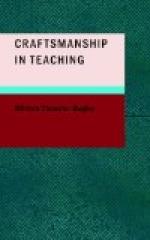But my chief reason for choosing his work as a type is that it represents a successful effort to supervise that part of school work which is most difficult and irksome to supervise; namely, the formation of habits. Whatever one’s ideals of education may be, it still remains true that habit building is the most important duty of the elementary school, and that the efficiency of habit building can be tested in no other way than by the means that he employed; namely, the careful comparison of results at successive stages of the process.
II
The essence of a true habit is its purely automatic character. Reaction must follow upon the stimulus instantaneously, without thought, reflection, or judgment. One has not taught spelling efficiently until spelling is automatic, until the correct form flows from the pen without the intervention of mind. The real test of the pupil’s training in spelling is his ability to spell the word correctly when he is thinking, not about spelling, but about the content of the sentence that he is writing. Consequently the test of efficiency in spelling is not an examination in spelling, although this may be valuable as a means to an end, but rather the infrequency with which misspelled words appear in the composition work, letter writing, and other written work of the pupil. Similarly in language and grammar, it is not sufficient to instruct in rules of syntax. This is but the initial process. Grammatical rules function effectively only when they function automatically. So long as one must think and judge and reflect upon the form of one’s expression, the expression is necessarily awkward and inadequate.
The same rule holds in respect of the fundamental processes of arithmetic. It holds in penmanship, in articulation and enunciation, in word recognition, in moral conduct and good manners; in fact, in all of the basic work for which the elementary school must stand sponsor. And one source of danger in the newer methods of education lies in the tendency to overlook the importance of carrying habit-building processes through to a successful issue. The reaction against drill, against formal work of all sorts, is a healthful reaction in many ways. It bids fair to break up the mechanical lock step of the elementary grades, and to introduce some welcome life, and vigor, and wholesomeness. But it will sadly defeat its own purpose if it underrates the necessity of habit building as the basic activity of early education.




